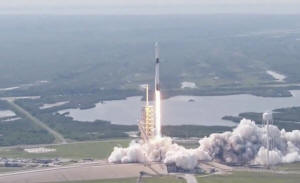|
SpaceX launches new rocket primed for
future crewed missions
 Send a link to a friend
Send a link to a friend
 [May 12, 2018]
By Joey Roulette [May 12, 2018]
By Joey Roulette
CAPE CANAVERAL, Fla. (Reuters) - An updated
version of the SpaceX Falcon 9 rocket, tailored for eventual crewed
missions for NASA, made its debut launch on Friday from Florida's Cape
Canaveral carrying a communications satellite for Bangladesh into orbit.
The newly minted Block-5 edition of the Falcon 9 - equipped with about
100 upgrades for greater power, safety and reusability than its Block-4
predecessor - lifted off at 4:14 p.m. EDT (2014 GMT) from the Kennedy
Space Center.
Minutes later, the rocket's main-stage booster flew itself back to Earth
to achieve a safe return landing on an unmanned platform vessel floating
in the Pacific Ocean.
The recoverable Block-5 booster is designed to be reused at least 10
times with minimal refurbishment between flights, allowing more frequent
launches at lower cost - a key to the SpaceX business model.

Enhanced rocket reusability also is a core tenet of SpaceX owner and
billionaire entrepreneur Elon Musk's broader objectives of making space
travel commonplace and ultimately sending humans to Mars.
SpaceX has safely return-landed 24 of its boosters and reflown 11 of
them.
Friday's flight marked the ninth SpaceX launch so far this year,
compared to five orbital-class missions the company had logged at the
same point in 2017, according to Musk.
It came a day after the original launch countdown was halted one minute
before blastoff time due to a technical problem detected by the rocket's
onboard computers. Friday's second attempt by SpaceX, formally known as
Space Exploration Technologies, appeared to have gone off without a
hitch.
The rocket's payload, the Bangladeshi government's first communications
satellite, Bangabandhu-1, was placed into Earth orbit at 4:47 p.m. EDT,
just 33 minutes after launch, according to SpaceX.
[to top of second column]
|

The SpaceX Falcon 9 rocket, tailored for eventual crewed missions
into orbit, makes its debut launch from Florida's Cape Canaveral,
carrying a communications satellite for Bangladesh May 11, 2018.
SpaceX/Handout via Reuters

The achievement was hailed by Bangladesh Prime Minister Sheikh
Hasina in a livestream appearance from her country's capital, Dhaka.
"Today is a very delightful and glorious day for our motherland,
Bangladesh, and Bangalee nation," she said. "With launching of
Bangabandhu Satellite-1, we are hoisting our national flag in the
space."
The Block-5 also marks another milestone for Musk's California-based
company. It is expected to be the first SpaceX vehicle to satisfy
NASA's standards for its Commercial Crew Program to carry agency
astronauts to the International Space Station. NASA requires seven
successful flights before the new rocket receives final
certification for a manned mission.
Besides missions to the space station, the new rocket will be used
to launch U.S. Air Force global positioning satellites and other
high-value, military and national security payloads.
Block-5 marks the final version of the Falcon 9 lineup before SpaceX
introduces its super heavy-lift launch vehicle, dubbed the Big
Falcon Rocket, or BFR, which will be designed to send manned
missions to Mars.
SpaceX is one of two private companies hired by NASA to ferry
astronaut crews to the space station. The other is Boeing Co.

(Reporting by Joey Roulette in Cape Canaveral; Writing by Steve
Gorman; Editing by Richard Chang)
[© 2018 Thomson Reuters. All rights
reserved.]
Copyright 2018 Reuters. All rights reserved. This material may not be published,
broadcast, rewritten or redistributed.
Thompson Reuters is solely responsible for this content. |